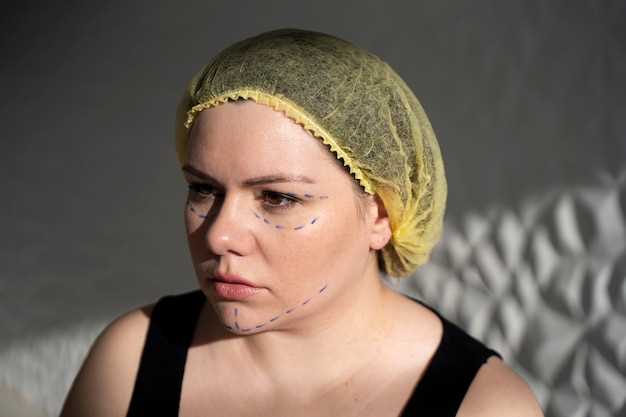Make a definitive plan now: evaluate your pre-surgical health and consult a dedicated team before you undergo a facial rejuvenation procedure. This approach centers on data-driven decisions and a clearly staged path that minimizes complications.
Following the latest briefing, the subject’s status has been tracked with a focus on nutrition, weight management, and cardiometabolic risk. As revealed, the team, based on the following metrics, will determine if the person is well enough to proceed. The sign of readiness comes from stable vitals, adequate hydration, and a clear plan for postoperative care.
To undergo a facial rejuvenation safely, address your weight and skin health. The nutrition plan should aim to improve skin elasticity and reduce the risk associated with the operation. A plan to manage obesity and comorbidities reduces the chance of complications during recovery.
The following findings from tyla and rubin’s team emphasize physical readiness and issues faced: skin quality, tissue support, anesthesia tolerance, and a realistic recovery window. If these factors show stability, the plan can advance. The patient has barely met the safety thresholds and will need a structured prehab program.
For readers considering a similar path, dont skip a Saturday check-in with your medical crew and ensure a well-coordinated post-operative nutrition and rehabilitation plan. Seeing concrete progress markers–hydration targets, nutrition adherence, and a steady activity schedule–helps quantify progress and minimize risk.
Practical breakdown of Tammy Slaton’s facelift journey, weight loss, and audience response
Consultation with a board-certified doctor is essential to judge feasibility, especially when tissue quality and past medical history are factors. In this path, the specialist will assess facial tissue layers, bone support, and potential for scar visibility, and will outline a realistic milestone timeline. For support, a sister or family member can help track progress; the plan should be based on prior medical notes and current health, with August as a preferred window for initial planning; these steps reduce the risk of post-operative chaos and ensure the mind stays focused on growth.
Weight management remains pivotal alongside any procedure. A practical plan starts with a nutrition framework, a gradual calorie reduction, and a weekly move target; researchers and doctors agree that sustainable loss comes from steady daily choices, not dramatic shifts. For five weeks after any improvement, monitor swelling and pain, then adjust. The audience often references shows that chronicled a long-term arc; their feedback can be incredibly positive when progress is steady and the tone remains transparent. Focus on regular medical check-ins and avoid extremes; this keeps physical recovery on track while the growth plan proceeds.
The audience response hinges on authenticity and clear communication. Posts that explain challenges, celebrate small wins, and acknowledge setbacks tend to leave the mind at ease and increase engagement. Comments from sisters or close friends of the subject often reveal a shared story, with nieces or relatives offering support. The narrative that shows resilience in the face of chaos tends to perform well on hollywood platforms, where viewers seek real growth rather than perfection. These signals can guide content creators to adjust tone, pacing, and timing, which helps these audiences feel heard.
Implementing a practical plan requires disciplined steps: align with a doctor on a realistic physical change path, set a milestone calendar, and prepare for post-procedure care with a trusted sister or partner. Document progress honestly and remove distractions that fuel issues and fear. Based on the past, most successful outcomes rely on steady routines, a support system, and a clear mind. Always keep these goals in sight, and use the August window for milestones or updates to maintain coherence with fans and shows that follow the story left by years of shared content.
What the facelift entails: techniques, scarring, and a realistic recovery timeline
Consult a board-certified surgeon to review pre-surgical health and set a realistic recovery timeline. This approach prioritizes wound care, incision strategy, and the latest techniques used to refine contours after a facial lift.
Techniques focus on lifting sagging tissue while preserving natural expression. Surgeons tailor incisions along hairline and natural creases to minimize visible scars. Precise skin redraping, muscle tightening, and, when appropriate, targeted fat grafting help achieve a balanced chin and jawline. The goal is to avoid a robotic look and keep the outcome harmonious with the patient’s age and health.
Recovery timeline includes a staged process: initial swelling and tenderness for the first weeks, with gradual softening of features. Within the first two weeks, most patients notice the incision lines fading; by week three to six, many see continued contour improvement. By 08-20, specific clinics document reduced puffiness and improved skin tone in many cases; by 08-22, patients often report more comfortable movement and clearer results from the lift. Full results typically emerge over months and become clearer over years, as tissues settle and scar maturation completes.
Scar care matters: keep incisions clean, avoid sun exposure, and follow doctor instructions on compression and massage. Wound healing progresses with good sleep, nutrition, and avoiding smoking. Pictures from early days and later milestones help track changes and set realistic expectations for the outcome.
Consider the local market context: patients, clinics, and business dynamics in communities like Madisonville shape access to care and the visibility of results. Getting reliable information from trusted clinics helps patients avoid misinformation. Seeing before/after pictures and verified reviews contribute to approval from family and the patient’s social circle, while haters dropped comments online; the pragmatic approach is to focus on personal health, recovery pace, and expert guidance. Realistic planning, ongoing follow-up, and a clear plan for maintenance amplify long-term growth without unnecessary risk.
Skin removal surgery details: affected areas, risks, and expected results
Schedule a consultation with a board-certified plastic surgeon to assess skin laxity and set a precise, personalized plan for removal. Obtain a written recovery timeline, expected scar locations, and a risk disclosure tailored to prior weight loss history. The focus sits at the center of the decision-making process, ensuring safety and realistic goals.
Affected areas commonly addressed in these procedures include:
- Abdomen (lower and upper), including the flanks
- Upper arms (bat wings)
- Thighs (inner and outer)
- Back and buttocks
- Chest area where excess skin remains after weight loss
Risks to discuss with the surgeon:
- Infection and delayed wound healing
- Seroma or hematoma requiring drainage
- Permanent scarring with contour changes or asymmetry
- Temporary numbness or changes in sensation
- Adverse reaction to anesthesia
- Fluid collections and potential need for revision surgery
- Impact of smoking or inadequate wound care on healing
Expected results and timelines:
- Removal of excess skin improves appearance and contour of the torso and limbs
- Incisions lie in natural folds; scars are long and will gradually fade, but remain visible
- Over time, swelling subsides and the tissue settles to reveal the final shape
- Final appearance is best assessed after several months; long-lasting results depend on weight stability and healthy lifestyle
Recovery and milestones:
- The procedure is lengthy and can be an eight-hour operation under appropriate anesthesia
- Initial activity restrictions typically last 2–4 weeks, with a gradual return to normal function
- Follow-up visits track progress, and the following weeks reveal the true shape change
Public interest context:
Hollywood narratives often spotlight dramatic shifts, yet the real path requires time, commitment, and careful aftercare. Updates around 07-23 and 08-22 illustrated the ongoing journey, with fans watching moments of progress. dont expect miracles, and understand that the center of improvement emerges over time as the appearance becomes clearer.
Personal context and family notes:
For a 38-year-old looking to improve appearance after weight loss, who is a mother of a daughter, the story also involves family input. sister beth and rhiannon have shared updates with fans, marking progress and offering practical tips for recovery. In August, attention centered on recovery milestones and how the body responds to the course of care. The reality for many who show results is measured in moments of gradual change, not overnight transformation, with the following timeline guiding expectations: initial sensitivity and barely noticeable changes eventually give way to a more confident silhouette.
Postoperative recovery essentials: daily routines, activity limits, and when to seek help
Follow a concrete rule: sleep with your head elevated on two to three pillows for the first week to reduce swelling; use cold packs as directed during the first 48 hours, then switch to gentle heat if advised by your team. Keep the incision area clean and dry to minimize infection risk and support healing.
Daily routines should include a brief, progressive plan: 10–15 minutes of slow walking, light self-care, and ample rest. Prioritize protein-rich meals, hydration, and foods high in vitamin C to support skin and tissue growth; this approach supports health during the recovery period and growth over the coming weeks.
Activity limits: no heavy lifting above 10–15 pounds for at least two weeks; avoid bending, twisting, and rapid head movements during the first week; avoid sun exposure on treated skin until cleared; resume activities gradually under the team guidance.
Pain management and wound care: take prescribed analgesics and any antibiotics as directed; avoid NSAIDs if advised by the surgeon; keep incisions clean and dry; change dressings only as instructed; removal of stitches or Steri-Strips occurs according to the surgeon’s plan.
Skin around the chin and neck area may show bruising and swelling; use gentle skincare and moisturizers as advised; protect the area from sun with clothing or sunscreen after healing; the face-lift incision will require time to fade; removal of tapes or clips will be done by the medical team.
Nutrition: maintain protein intake, hydration; weight-loss history should be considered; include lean protein, greens, and vitamin C to support skin healing; avoid alcohol until cleared by the team.
Emotional health and expectations: reality can include chaos in the early days; focus on small smiles and steady progress; their sister and people around provide support; slaton posted updates in series and episode formats; posted pictures from the progress can have an impact on viewers and fans who follow the story.
When to seek help: contact the surgeon immediately if there is fever above 38 C, increasing redness or warmth around incisions, foul drainage, severe or worsening pain, wound opening, shortness of breath, chest pain, or dehydration, especially if these signs appear before a scheduled follow-up. Do not wait for a problem to worsen; call the clinic to check in.
Record notes: maintain a daily log of swelling, color changes, pain level, and any new sensations. If swelling fades and skin tone begins to even out, that deserves acknowledgment; posted updates should respect privacy; the team will monitor progress and adjust the plan as needed.
Cost, insurance, and options for weight-loss-related skin procedures
Begin with a thorough center consultation to map costs, approval paths, and realistic timelines. Viewers often want a little concrete data, not guesses, and a focused plan helps the process stay on track. five major options exist, spanning surgical removal and non-surgical refinements, with a dedicated team guiding the next steps. If you have a question, a clinician can address it during the visit to save time.
Insurance coverage tends to hinge on medical necessity rather than cosmetic goals. Document functional issues (skin irritation, persistent rashes, mobility limits), gather photos, and secure physician notes. rhiannon from the team can coordinate the preapproval packet and seek approval where possible. In many centers, preapproval requires a letter detailing how excess skin affects daily life and a history of weight stability. If approval is granted, most plans cover part of the surgical cost; otherwise, patients pay out of pocket or finance through care credit. haters aside, getting a clear answer from the insurer is essential to plan the next step. leaves drop into the inbox daily; updates posted to the portal can help mind the timeline and reduce surprises. This process can save time for everyone involved, and if you have a question, ask during the consult.
Non-surgical refinements such as radiofrequency or ultrasound tightening, laser resurfacing, and targeted injections can offer modest improvements with less downtime, but results are subtle and time-limited. For substantial excess skin, surgical removal provides more durable contour changes. The scope typically includes abdominal, flank, arm, thigh, or buttock areas, with abdominoplasty, lower body lift, brachioplasty, thigh lift, and panniculectomy among the most common paths. Myself, from experience, seeing the results can be stunning when expectations align with recovery, and sister clinics often confirm the same pattern. A careful discussion of risks, recovery, and realistic outcomes is essential.
Costs shift ever with region, facility, and case complexity. In the United States, total surgical contouring costs can range from about $9,000 to over $25,000 for extensive procedures, while single-area operations often fall in the $3,500–$15,000 range. Non-surgical tightening options are typically $1,000–$4,000 per year if maintenance is chosen. Financing plans, payment programs, and facility discounts exist; many centers offer options that spread the balance over months. Early engagement with a financial counselor helps maximize approval potential and minimize surprises; posted notes from 07-23 show centers that post clear estimates and define out-of-pocket costs upfront.
| Procedure type | Estimated total cost range | Insurance coverage likelihood | Typical preapproval steps |
|---|---|---|---|
| Abdominoplasty (tummy tuck) | $9,000–$15,000 | Often partial; depends on functional issues | Medical notes, photos, surgeon letter |
| Lower body lift | $12,000–$25,000 | Limited; rare without documented impairment | Document symptoms, return-to-work plan |
| Arm lift (brachioplasty) | $3,500–$8,000 | Usually not covered for cosmetic purposes | Photos, history, preop clearance |
| Thigh lift | $4,000–$9,000 | Occasional coverage if functional issues exist | Careful documentation, preapproval |
| Panniculectomy | $4,000–$12,000 | Can be covered if skin irritation is documented | Medical necessity evidence, clearance |
| Non-surgical tightening (RF/ultrasound) | $1,000–$4,000 per year | Usually not covered | Consultation, multiple sessions, aftercare |
Evaluating online chatter: identifying credible information and common fan questions
Always verify any health- or appearance-related claim via primary sources–an official interview, the Slaton team update, or the latest episode notes. This approach helps separate confirmed details from speculation; another credible update admitted progress and ongoing challenges, which informs how the impact on mobility and lifestyle is understood; posts that flaunt changes without a source mislead anymore.
- Source credibility: prioritize direct quotes from verified channels, official press releases, or statements from medical professionals connected to Slaton. If a post admitted limitations or progress, it tends to be more reliable than anonymous claims.
- Context and dates: verify when the information was published and whether it ties to a specific episode or the July window. Cross-check with the interview transcript or team update to confirm alignment.
- Visual verification: examine photos or clips for edits or miscaptioning; prefer material from verified accounts and compare with prior images to assess consistency in appearance or mobility.
- Medical and lifestyle claims: separate factual statements about nutrition, health, and mobility from speculation. If numbers appear (for example, blood indicators), seek corroboration from credible sources or the official update.
- Speculation patterns: be wary of anonymous quotes and sensational language. Claims lacking a named source or direct link to an interview or episode should be treated as tentative.
Common fan questions, with guidance on credible sources:
- What is the current mobility status and daily routine based on the latest interview or July update?
- Are there credible statements about health indicators, nutrition, or blood work, and where do those numbers come from?
- Is there any credible information about a face-lift or cosmetic procedure, and who admitted specifics if any?
- How has the lifestyle changed, including any adjustments to treatment or a new routine with the health team?
- What is the plan for forthcoming episode coverage or business updates associated with Slaton?
- Which channels should fans monitor to receive updates, and how can they verify a post’s legitimacy?
Practical verification checklist:
- Follow the official interview page and the Slaton team profile for direct quotes and dates.
- Cross-check any nutrition or health claim with a licensed professional or a documented medical note from the period around the update.
- Compare the July update details with the latest episode recap to confirm alignment in facts.
- Discard posts lacking a direct source or with inconsistent imagery; seek a credible alternative before sharing.
- Keep in mind the broader context: the lifestyle changes, challenges, and ongoing care plan reported by Slaton or the slatons team. Having faced health challenges, Slaton has emphasized nutrition and medical oversight with the team, which shapes how any claim should be weighed. with this approach, you reclaim clarity from noise and focus on information that is possible to verify.
For readers and tammys: use the official channels, ask precise follow-up questions in comments, and avoid amplifying unverified narratives that lack a solid source. This practice helps the discussion stay informative and grounded in verifiable details rather than speculation about the future.

 Tammy Slaton’s Facelift Could Be Her Biggest Milestone Yet">
Tammy Slaton’s Facelift Could Be Her Biggest Milestone Yet">


